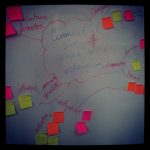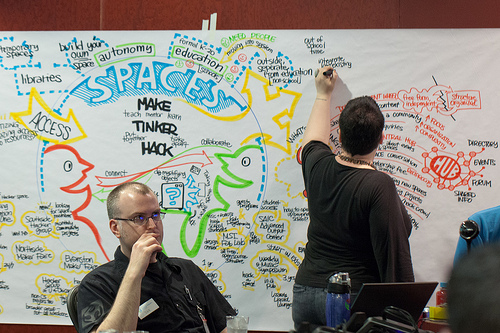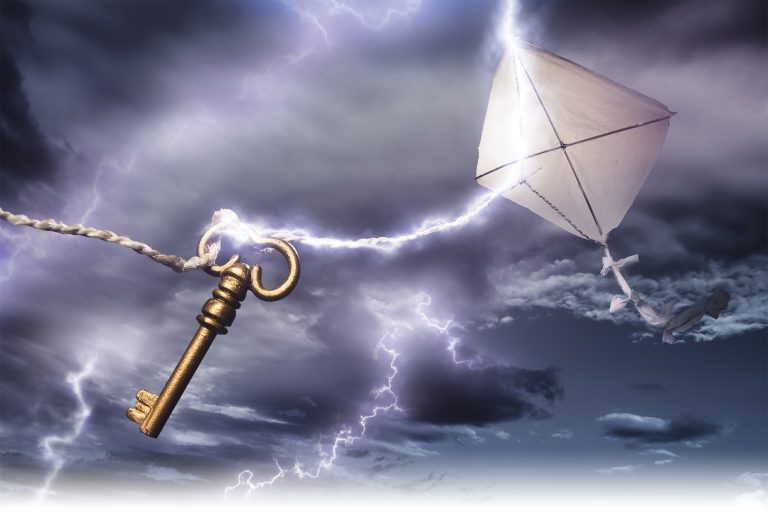Harnessing the Storm in Your Brain through Mind Mapping
Have you ever tried to brainstorm an idea, only to find yourself with pages of information, but no clear view of how it all fits together? Or you look down at all the random words and have no idea what to do next?
Last week I talked about the difficulties of brainstorming, and how intimidating that process can be. Many writers have no clear methods to help them generate ideas, or take ideas to the next stage, which will lead to a finished product of a blog post, article, or work of fiction. This is where the technique of mind mapping can help you.
A Different Kind of Map
Mind maps are much like a travel map, although a bit chaotic at first glance. A mind map is created on a piece or paper or tagboard to capture and connect ideas so your brain has help in moving from the idea stage to the execution stage. This is the place writers often have the hardest time (myself included) in their creative process, for it’s here where we shift from pure inspiration to the nuts and blots of logical organization and planning. So mind maps act as a bridge to get you across that daunting chasm.
Ways a Mind Map Can Help Your Writing Process
One great benefit of mind mapping is it can quickly identify and understand the structure of a subject or theme. Mind maps help you see the way that pieces of information fit together, and help you remember information, as they hold it in a format that your mind finds easy to recall and quick to review.
Instead of writing pages of notes, mind mapping is a way of word/idea associating that helps generate new ideas. Reading through pages of notes can be tedious and doesn’t often aid us in organizing those ideas.
When I brainstorm my novels, I write pages and pages of notes, as freewriting is a method that really works for me in drawing out new ideas, characters, and themes for my stories. However, if I just stopped at writing notes, I would be really stuck as to how to proceed. It’s very hard to go from pages of notes to jumping in and writing a novel straight through, so there are mind mapping techniques—visual and tactile aids—that help me bridge idea to execution.
Manageable Chunks
When you mind map, you use one piece of paper. You break large projects or topics down into manageable chunks so that you can plan effectively without getting overwhelmed and without forgetting something important. By creating a “shape” of your ideas on one piece of paper, you find it easier to remember the components, which will aid when you get down to actually writing. You can use a mind map when brainstorming ideas, to summarize info and notes, consolidate info from different sources, to think through problems, and to study and memorize info.
How to Draw a Mind Map
- Write the title of the subject (or a key idea) you’re exploring in the center of the page, and draw a circle around it.
- As you come across major subdivisions or subheadings of the topic (or important facts that relate to the subject) draw lines out from this circle, like the beginnings of a spiderweb. Label these lines with these subdivisions or subheadings.
- As you “burrow” into the subject and uncover another level of information (further subheadings, or individual facts) belonging to the subheadings, draw these as lines linked to the subheading lines.
- Then, for individual facts or ideas, draw lines out from the appropriate heading line and label them.
- As you come across new information, link it in to the mind map appropriately.
 A complete mind map may have main topic lines radiating in all directions from the center. Subtopics and facts will branch off these, like branches and twigs from the trunk of a tree. You don’t need to worry about the structure you produce, as this will evolve of its own accord.
A complete mind map may have main topic lines radiating in all directions from the center. Subtopics and facts will branch off these, like branches and twigs from the trunk of a tree. You don’t need to worry about the structure you produce, as this will evolve of its own accord.
Software tools are available if you want to do this the techie way. Bubbl.us, MindGenius, iMindMap, or Mindjet can improve the process by helping you to produce high quality mind maps, which you can then easily edit or redraft. Here’s a great review of the top five mind-mapping software tools.
Using Mind Maps Effectively
Once you start playing with mind mapping, no doubt you’ll come up with methods and variations that work for you. Here are some tips:
- Start with a big piece of paper, but preferably a large piece of tagboard.
- Use single words or simple phrases. Single strong words and short, meaningful phrases can convey the same meaning more potently. Excess words just clutter the mind map.
- Use color to separate different ideas. Colors help you to visualize the mind map for recall and can help to show the organization of the subject. I use different colors for each character when brainstorming scene ideas, to indicate whose POV the scene will be in.
- Use symbols and images. Pictures can help you to remember information more effectively than words, so, where a symbol or picture means something to you, use it. You can cut out pictures from magazines or do Google searches for images and print out pictures that you can then tape onto your chart.
- Use cross-linkages. Information in one part of a mind map may relate to another part. Here you can draw lines to show the cross-linkages. This helps you to see how one part of the subject affects another.
I find getting back into “kindergarten mode” is the most stimulating creatively. Don’t be afraid to pull out the colored pens, sticky notes, crayons. Let your right brain have some room to play, and you may be surprised to see how much easier those ideas will flow. Using this technique of mind mapping might be just the thing to help you transform your random bits of ideas into coherent concepts that will give you firm direction on how to move forward to executing a great piece of writing.
Next week, I’m going to give novelists some specific examples on how mind mapping can be terrific for brainstorming all the components of a story. By sharing some techniques I use to bring chaos into order, I hope to help you feel less trepidation and more excitement over this stage of the novel-writing process.
Happy mapping!












Excellent post, thank you!
I’m a long-time mind-mapper, and for the past five years or so I’ve been using the program from http://www.thebrain.com, and for many years before that, MindJet. The Brain program can sync to the cloud and all of my thoughts are managed seamlessly between multiple desktops and laptops, and available on the web. An iOS and Android app is in the works. I personally prefer it, hands down, to MindJet.
I use The Brain for presentations in the classes I teach, and I use it for my fiction, non-fiction, work lists, or anything that I want to remember. The Brain (Pro version) has an Outline mode that I use the most. I also use Evernote hand-in-hand with The Brain.
For my first non-fiction book I have over 2000 thoughts in my mind map (http://tinyurl.com/kkos7g5) and for my first novels I’m up to over 9000 thoughts, including the craft of writing, science, and ideas for the novels (http://tinyurl.com/me9zgav). Mind Mapping, in general, has always worked well for me.
For anyone starting to use Mind Maps, remember that using it is a habit like anything else, and you have to keep using it until it is second-nature. If everything goes into the map (and/or Evernote), then it will be there when you need it, and grow as a useful tool.
Again, excellent post, and thank you for all you do!
– Jenni
I have looked into mind mapping for years and never seriously put it to use. I am in a muddle now, with so many things I want to write, and admit I need to great tool. Thank you for this great post which for me, is a motivation to do what I should to get going in the right direction.
—Barb J
Insightful post, thank you. I use mind mapping all day, in everything I do, to tame my brain.
When I’m writing, I create an initial “everything and the kitchen sink” mind map. Then I choose two or three items and free write about them for five or ten minutes.
After taking a break to clear my mind (make a cup of coffee) I come back and revise the mind map, incorporating the insights from free writing.
At this stage, I’ve choose my slant for the piece, and may do some research (contact people for interviews).
Basically, I create a big mind map, then trim away everything which doesn’t fit into a slant for a piece. If I’m writing a book, this process goes on many times.
Dear C.S.:
I loved your report last week, but this one, I just can’t wrap my mind around. I think I must be different from most people. In one of my books I wrote titled ‘The Vessel’ I saw the spit-tomb like vase under our TV. After looking at that vessel for several nights (only momentarily) I saw the book I wrote almost in it’s entirety. It has 270 pages and 79,000 words. It’s a good book (As I see it.) with lots of twist and turns in the plot. If I had tried to harness the thoughts in a wad I can’t say how it would have turned out. I love the though of knowing parts you can add, it’s just that I already have the story ready to put into words.
Please—don’t think for one moment I don’t approve of your method. Some people just have to have an outline to progress and the ones that do should follow your directions. I am an avid fan of yours and will be watching your post.
Best regards,
James M. Copeland
Hi James, just came in on a mind map hunt. I’m a long time mind mapper (15 yrs.) and write creatively. I don’t plot my novels or plays but still use mindmaps. I use them to discover themes, work out tangles or sometimes to just get going after a break. Nobody needs to use every tool but thought you might like to know that pantsers (as we intuitive writers are sometimes called) use mindmaps too.
I read your posts about mind-mapping and it was very timely as I have been looking for mind-mapping software. Last night, I was having a “where to go from here” moment and remembered your post. Duh! I have paper and colored pens in front of me.
Within a half an hour, I had five sheets connected together of arrows and tidbits and could see places I could put a twist or another connection. I am now 1-2 sheets away from having a map for the rest of my WIP from some basic sentences (thanks to your last workshop with JSB).
Now I can scan them and put them in Dropbox or Google docs and I have access to them anywhere and don’t have to buy more software (the free mind-mapping ones don’t have the functionality I want).
Thank you for your help!
Glad this is helping. The next few posts will be specific showing how to create maps for plot, characters, setting, etc.
It’s becoming increasingly clear that I will have to rid my desk of clutter to make this happen, but I work full-time writing non-fiction so it’s going to be a tough challenge.
Although I’m a horrible artist, I think in pictures (and in color), so mapping might just be the key to getting past the 6,000 words I’ve been stuck in/with for the past few months.
Brainstorming really helps, and my new release–The 12 Key Pillars of Novel Construction–will have a workbook released along with it (I hope to get it done soon!). The workbook will include more than a dozen mind maps that I’ve done to show ways to generate these ideas. So I hope they help you!
There’s definately a great deal to learn about this subject.
I like all the points you made.